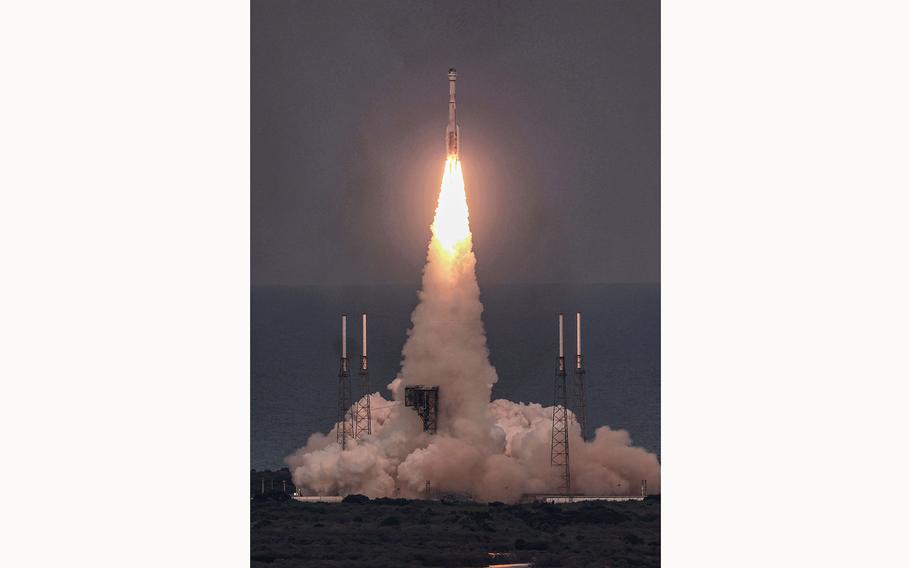
The Boeing CST-100 Starliner launches from Cape Canaveral Space Force Station, on May 19, 2022, as seen from Florida's Kennedy Space Center. (Joe Burbank/Orlando Sentinel/TNS) (Joe Burbank)
(Tribune News Service) — Boeing’s CST-100 Starliner and its two NASA astronaut passengers cannot come home yet, but officials said a decision could come next week on when they could make their return to Earth.
“I think we’re starting to close in on those final pieces of the flight rationale to make sure that we can come home safely,” said NASA Commercial Crew Program manager Steve Stich during a media update Thursday.
Butch Wilmore and Suni Williams arrived to the International Station back on June 6 one day after launching in Starliner atop a United Launch Alliance Atlas V rocket from Cape Canaveral Space Force Station. They’re flying on the Crew Flight Test mission, the first human spaceflight for Starliner as part of Boeing’s efforts to play catchup and join SpaceX to provide rides to and from the ISS from the U.S.
While it was originally targeting an eight-day stay on board the ISS, the duo have now been on the station more than 50 days as Boeing and NASA work through issues found during the flight up with both helium leaks and failed thrusters on Starliner’s propulsion system. The earliest Starliner could leave the ISS would likely be mid-September.
“We kept saying eight-day minimum mission,” said Boeing’s Mark Nappi, vice president of the company’s commercial crew program. “I think we all knew that it was going to go longer than that. We didn’t spend a lot of time talking about how much longer but I think it’s my regret that we didn’t just say we’re going to stay up there until we get everything done that we want to go do.” That to-do list has meant making sure teams understand why five thrusters failed as Starliner approached the ISS as well as figure out the reason behind several small helium leaks in the spacecraft’s service module.
While docked, the helium leaks have been locked down, and NASA and Boeing were able to refire four of the five thrusters back into working condition, although at lower than optimum power levels.
While teams had already signed off on Williams and Wilmore being able to use Starliner in the case of emergency, the decision was made to go through a series of tests on the ground at NASA’s White Sands Test Facility in New Mexico, which were completed last week.
At issue is the service module will be jettisoned before Starliner’s reentry so Boeing and NASA won’t get their hands on the hardware to look closer at why it suffered the failures that it did. The ground testing and delay in return for Starliner is designed to help remedy any problems for the six contracted future flights for Starliner to the ISS.
The good news is the teams think they have the likely source of the thruster issue after running through an intensive set of tests replicating both the stresses and heat conditions the spacecraft endured on the flight up, as well as what teams expect for the flight home. The thrusters will be needed for the deorbit burn.
Teams were also able to find a likely source of the helium leaks by looking at a Starliner service module that had been set aside from 2021, and found “degradation” in seals that were exposed to nitrous oxide vapor over the last three years, something similar to what the CFT service module would have experienced at lower levels during the three months leading up to its launch. The solutions for future launches may be require changes in seal material and even adjusting how Starliner flies and how often it uses its thrusters to limit heat buildup.
“We looked at the data. It really does replicate well what we’re seeing in flight,” Nappi said. “So we think these findings are very significant and are likely the root cause. Obviously, knowing root cause is what gets us to permanent fixes. So there’s very strong evidence, and we’re going to continue to take that hardware apart so that we can finally prove this.” What’s next for Starliner is another hot fire test on board the ISS this weekend while Boeing finishes up its report from the White Sands testing.
“We’ll work to execute an agency review as soon as we’re ready to do that. That could be as early as late next week,” Stich said. “We are following the data, and we’ll schedule that review when we need to. And then after that we’ll set the the undock time.” Stich said the decision to come home can be made after teams understood why the helium was leaking and knowing the leaks could be controlled for a safe flight home.
“We understand the stability of the leaks and how we can manage those should they get bigger,” he said. “We have a criteria in place that we have established a leak rate that we’ll check before undock and verify that system is good to go.” And then it’s confirming the thrusters will be where they need to be for the flight home.
“The hot fire test this weekend will give us confidence in all the thrusters,” he said. “That’s really I think the final pieces of the flight rationale that we need to put together. …. and we’ll come home when we’re ready.”
©2024 Orlando Sentinel.
Visit orlandosentinel.com.
Distributed by Tribune Content Agency, LLC.